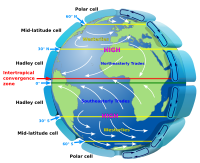
Photo from wikipedia
ABSTRACT Windstorms result in significant damage and economic loss and are a major recurring threat in many countries. Estimating surface-level wind speeds resulting from windstorms is a complicated problem, but… Click to show full abstract
ABSTRACT Windstorms result in significant damage and economic loss and are a major recurring threat in many countries. Estimating surface-level wind speeds resulting from windstorms is a complicated problem, but geostatistical spatial interpolation methods present a potential solution. Maximum sustained and peak gust weather station data from two historic windstorms in Europe were analyzed to predict surface-level wind speed surfaces across a large and topographically varied landscape. Disjunctively sampled maximum sustained wind speeds were adjusted to represent equivalent continuously sampled 10-minute wind speeds and missing peak gust station data were estimated by applying a gust factor to the recorded maximum sustained wind speeds. Wind surfaces were estimated based on anisotropic and isotropic kriging interpolation methodologies. The study found that anisotropic kriging is well-suited for interpolating wind speeds in meso- and macro-scale areas because it accounts for wind direction and trends in wind speeds across a large, heterogeneous surface, and resulted in interpolation surface improvement in most models evaluated. Statistical testing of interpolation error for stations stratified by geographic classification revealed that stations in coastal and/or mountainous locations had significantly higher prediction errors when compared with stations in non-coastal/non-mountainous locations. These results may assist in mitigating losses to structures due to excessive wind events.
Journal Title: Geomatics, Natural Hazards and Risk
Year Published: 2017
Link to full text (if available)
Share on Social Media: Sign Up to like & get
recommendations!